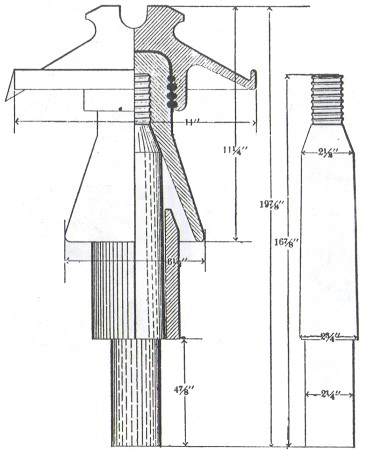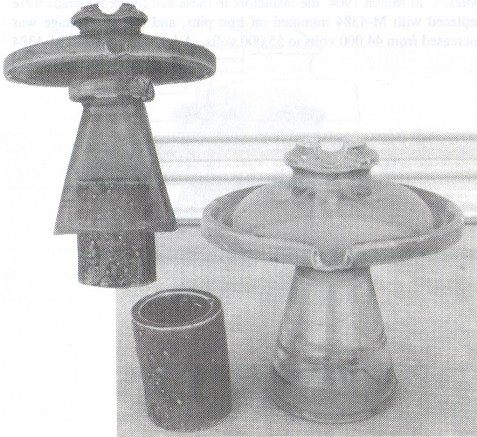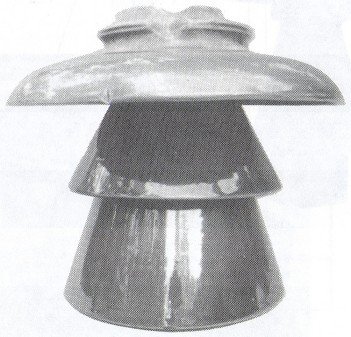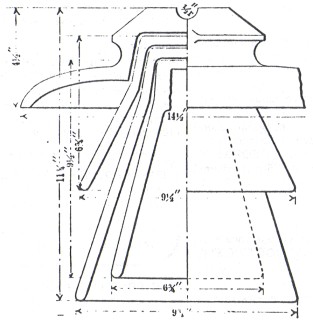Porcelain Insulator News
by Elton Gish
Reprinted from "Crown Jewels of the Wire", January 1994, page 15
In the September 1990 issue of CJ, we talked in some detail about the use of
M-2795 in northern California. More than 100,000 of these insulators were used
on two lines during 1900-1901. The top skirt was made of porcelain, with a
gutter around the outer edge and an eave spout to direct the water away from the
crossarm. The long bottom skirt was made of glass by the Brookfield Glass Co. The two parts were cemented together
with sulfur. The glass skirt protected the pin to some degree, but where the
line crossed fog prone areas, or during times of rain, the electricity would
leak across the surface and cause an arc from the bottom edge of the glass skirt
to the pin, which resulted in burning of the wooden pins. The following quote
was taken from the August 1901 issue of "The Journal of Electricity Power
and Gas":
"On the base of the pin is used a porcelain sleeve 5 inches long, which
rests upon the crossarm and projects up beneath the glass petticoat. The object
of this porcelain sleeve is to protect the pin in the event of an arc tending to
strike from the eave on the insulator to the base of the pin. It also protects
the pin from weathering."

Illustration of M-2795 taken from the February 1903 issue of
"The Journal of Electricity, Power and Gas", which shows
the porcelain sleeve around the wooden pin.
M-2795 was satisfactory under arid conditions, but the margin of safety was
exceeded during wet conditions. The top skirt acted as a flat pan that easily
collected dirt. In the 1903 "Journal of AlEE", an article titled,
"Bay Counties System", problems with dirt accumulating on M-2795 were
described: "The only place where we had trouble with the accumulation of
dirt on insulators was near salt water and cement works. Rain is Heaven's own
blessing ... it cleans the insulators and stops a good deal of the damage to
wooden supports [pins]. This is true of salt water districts especially. The
first few drops that fall after a prolonged dry spell causes a good deal of a
display which soon passes however and all is quieter and better than it was
before." The burning of pins was a constant problem near fog prone areas.
Some of the wooden pins were soon changed out with a pin made from steel gas
pipe, which had lead threads formed on the tapered end: Another solution was
patented by Fred M. Locke. His patent No. 698,976, dated April 29, 1902 (on
application filed November 11, 1901), claimed the use of a porcelain sleeve
around the pin.

M-2795 showing porcelain sleeve that was suppose to protect
the wooden pins
from being burned by electrical arcing.
M-2795 was fitted with a five-inch porcelain sleeve, that rested on the
crossarm and extended up inside the glass bottom skirt. Bill Rohde recently
discovered that he has one of these porcelain sleeves in his collection. He did
not know what it was until one day we were discussing the problem of M-2795 pins
being burned and the use of these simple porcelain sleeves. No other specimens
have been reported. Does anyone else have one of these porcelain sleeves? The
two photographs of M-2795 with the porcelain sleeve were taken by Bill Rohde.
Another interesting problem was observed along salt water fog areas, and
reported in the 1904 issue of the" Journal of AlEE". In the article
titled, "High-Tension Insulators", by V. G. Converse, R. S. Hutton
reported the problem with M-2795: "The separate parts of the first
ones used, were put together with sulfur, and we had some field fires that we
were not able to account for. We afterwards found out that it was due to the
fact that the leakage heated the insulator to such an extent that the sulfur was
set on fire, and as it dropped down, set the grass on fire around the
poles." In March 1904, the insulators in these salt fog prone areas were
replaced with M-4384 mounted on iron pins, and the line voltage was increased
from 44,000 volts to 55,000 volts. A few specimens of M-4384 have been located in California, and three of them have the #7 -1 marking. It
has been reported that some of the M-2795's that were removed from these lines
were shipped to Hawaii. Indeed, some specimens have been found there, but I do
not know where, or in what service they were used. M-4384 is the largest of the
Fred Locke insulators. The fourth skirt is recessed inside the bottom outer
skirt much like M-4320, M-4400, M-4415, M-4415A, M4420, and M-4425.

M-4348 Fred Locke
14.5 - 9.5 - 9.5 - 6.5 x 12.5
If you would
like to learn more about the development of the M-2795 and its use on the two
northern California lines, you will have to wait for my new book, which
hopefully will be available at the 1994 Houston National. The book will be a
rather detailed biography of Fred M. Locke. Much of Chapter 7 has been dedicated
to this fascinating insulator. Only two paragraphs from that book have been
reproduced here.

Illustration of M-4384 from July 1905 issue of "Electrical Age"
Porcelain Cochrane Bells?
|
